
Messier 13 or M13, is a globular cluster of several hundred thousand stars in the constellation of Hercules.

Messier 9 or M9 is a globular cluster in the constellation of Ophiuchus. It is positioned in the southern part of the constellation to the southwest of Eta Ophiuchi, and lies atop a dark cloud of dust designated Barnard 64. The cluster was discovered by French astronomer Charles Messier on June 3, 1764, who described it as a "nebula without stars". In 1783, English astronomer William Herschel was able to use his reflector to resolve individual stars within the cluster. He estimated the cluster to be 7–8′ in diameter with stars densely packed near the center.

NGC 2683 is a field spiral galaxy in the northern constellation of Lynx. It was nicknamed the "UFO Galaxy" by the Astronaut Memorial Planetarium and Observatory. It was discovered by the astronomer William Herschel on February 5, 1788.
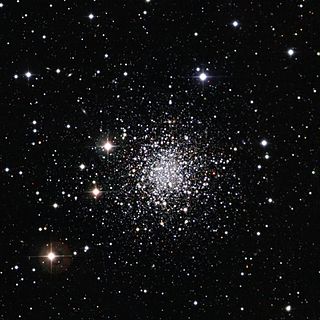
NGC 2257 is a globular cluster that lies on the outskirts of the Large Magellanic Cloud (LMC). It was discovered in 1834 by John Herschel. The compiler of the New General Catalogue, John Louis Emil Dreyer, described this cluster as "faint, considerably large, round, very gradually a little brighter middle, mottled but not resolved, 17.0 seconds of time diameter." At an aperture of 30.5 arcseconds, its apparent V-band magnitude is 12.62, but at this wavelength, it has 0.12 magnitudes of interstellar extinction.

NGC 6139 is a globular cluster of the Milky Way in the constellation Scorpius. It is located 3.6 kiloparsecs from the Galactic Center.

NGC 1783 is a globular cluster within the Dorado constellation and part of the Large Magellanic Cloud, a satellite dwarf galaxy of the Milky Way. At an aperture of 50 arcseconds, its apparent V-band magnitude is 10.39, making it one of the brightest globular clusters in the LMC as viewed from Earth. It was discovered in 1835 by John Herschel. The compiler of the New General Catalogue, John Louis Emil Dreyer, described this cluster as "considerably bright, large, round, very gradually pretty much brighter middle, mottled but not resolved."
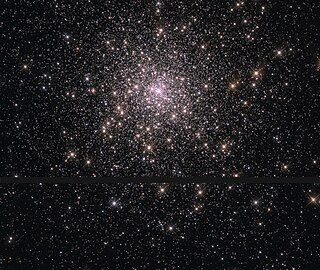
NGC 6284 is a globular cluster located in the constellation Ophiuchus. It is designated as IX in the galaxy morphological classification scheme and was discovered by the German-born British astronomer William Herschel on 22 May 1784. Its distance had previously been estimated at 49,900 light years from Earth, but this was revised in 2023 to around 43,000 light years. This same study, based on high-resolution Hubble Space Telescope optical observations, produced the first high-quality colour-magnitude diagram (CMD) of NGC 6284, extending down to about six magnitudes below its main sequence turn-off. The new observations moved its centre of gravity by 1.5–3 arcseconds from previous values, and its density profile showed a steep central cusp, suggesting that NGC 6284 is a post-core collapse (PCC) cluster.

NGC 6380 is a globular cluster located in the constellation Scorpius. It was originally discovered by James Dunlop in 1826, and he named it Dun 538. Eight years later, in 1834, it was independently rediscovered by John Herschel and he named it H 3688. The cluster was re-rediscovered in 1959 by Paris Pişmiş, who catalogued it as Tonantzintla 1 — and referred to it as Pişmiş 25. Until the 1950s NGC 6380 was thought to be an open cluster. It was A. D. Thackeray who realised that it was in fact a globular cluster. Nowadays, this cluster is reliably recognised in widely available catalogues as a globular cluster, and referred to simply as NGC 6380.
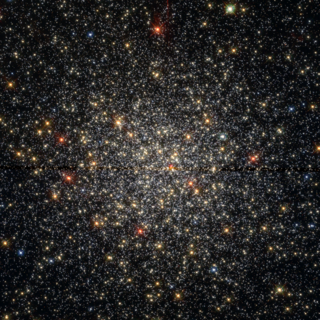
NGC 5927 is a globular cluster in the constellation Lupus. NGC 5927 has a diameter of about 12 arcminutes and an apparent magnitude of +8.86. Its Shapley–Sawyer Concentration Class is VIII, and it contains stars of magnitude 15 and dimmer.
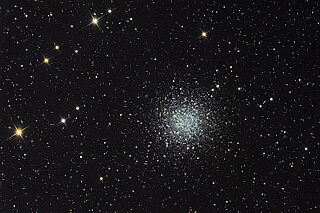
NGC 5897 is a globular cluster in the constellation Libra. This satellite of the Milky Way, which is quite remote, has a diameter of over 170 light years. With its Shapley–Sawyer Concentration Class of XI, it has very low star density even in its center.
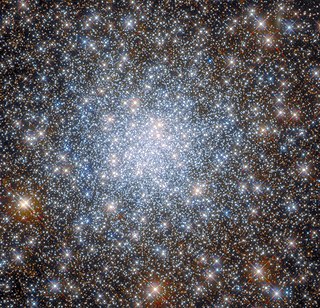
NGC 6638 is a globular cluster in the constellation Sagittarius. It is magnitude 9.5 and diameter 2 arc minutes, class VI. It is a half degree east of Lambda Sagittarii. It is a member of the Milky Way.
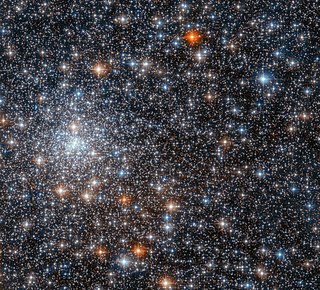
NGC 6558 is a globular cluster, located about 24,000 light years away in the constellation Sagittarius. Its apparent magnitude is about 11 and its apparent diameter is about 10 arcminutes. The globular cluster was discovered in 1784 by the astronomer William Herschel with his 18.7-inch telescope and the discovery was later catalogued in the New General Catalogue.

NGC 6528 is a globular cluster in the constellation Sagittarius, and is listed in the New General Catalogue. It has an apparent magnitude of about 11 and a diameter of about 16 arcminutes, and its Shapley-Sawyer Concentration Class is V, containing stars of 16th magnitude and dimmer. Dreyer described it as "pF, cS, R", meaning poor and faint, considerably small and round.

NGC 1466 is the New General Catalogue designation for a globular cluster in the deep southern constellation of Hydrus. It is located in the outskirts of the Large Magellanic Cloud, which is a satellite galaxy of the Milky Way. The object was discovered November 26, 1834 by English astronomer John Herschel. John Dreyer described it as "pF, pS, iR, glbM, *7 f", meaning "pretty faint, pretty small, irregular round, gradually a little brighter middle, with a 7th magnitude star nearby". When using a small telescope, this is a "faint, small, unresolved and difficult" target with an angular size of 1.9 arc minutes. It has an integrated visual magnitude of 11.4.

NGC 1846 is a globular cluster containing hundreds of thousands of stars in the outer halo of the Large Magellanic Cloud. It was discovered on November 6, 1826, by James Dunlop and is included in the New General Catalogue. At an aperture of 50 arcseconds, its apparent V-band magnitude is 10.68, but at this wavelength, it has 0.07 magnitudes of interstellar extinction.

NGC 416 is a globular cluster located in the constellation Tucana. It was discovered on September 5, 1826, by James Dunlop. It was described by Dreyer as "faint, pretty small, round, gradually brighter middle". At a distance of about 199,000 ± 9,800 ly (61,000 ± 3,000 pc), it is located within the Small Magellanic Cloud. At an aperture of 31 arcseconds, its apparent V-band magnitude is 11.42, but at this wavelength, it has 0.25 magnitudes of interstellar extinction.

NGC 419 is a globular cluster located approximately 57,000 pc (190,000 ly) from Earth in the constellation Tucana. It was discovered on September 2, 1826, by James Dunlop. It was described by Dreyer as "pretty large, pretty bright, round, gradually brighter middle". At a distance of about 186,000 light years, it is located within the Small Magellanic Cloud. At an aperture of 50 arcseconds, its apparent V-band magnitude is 10.30, but at this wavelength, it has 0.15 magnitudes of interstellar extinction.

NGC 5308 is an edge-on lenticular galaxy in the constellation of Ursa Major. It was discovered on 19 March 1790 by William Herschel. It was described by John Louis Emil Dreyer as "bright, pretty large" when he compiled the New General Catalogue. A small, irregular galaxy near NGC 5308 has been given the designation LEDA 2802348.

NGC 1624, also known as Sh2-212 in the Sharpless catalog, is a very young open cluster in the constellation Perseus inside an emission nebula. It was discovered by German-British astronomer William Herschel in 1790. NGC 1624 is about 20,000 ly from Earth, and latest estimates give it an age of less than 4 million years. Its apparent magnitude is 11.8, and apparent diameter is about 3.0 arc minutes. Its celestial location is right ascension (α) 04h 40m 36.0s and declination (δ) +50° 27′ 42″. It is potentially an area of massive star formation.

NGC 1381 is a lenticular galaxy located in the constellation Fornax. It is located at a distance of about 60 million light years from Earth, which, given its apparent dimensions, means that NGC 1381 is about 55,000 light years across. It is a member of the Fornax Cluster. NGC 1381 appears edge-on and features a thin disk with high surface brightness and a boxy bulge. Both the box-shaped bulge and the kinematics of the central area of the galaxy suggest that NGC 1381 has a bar.





















